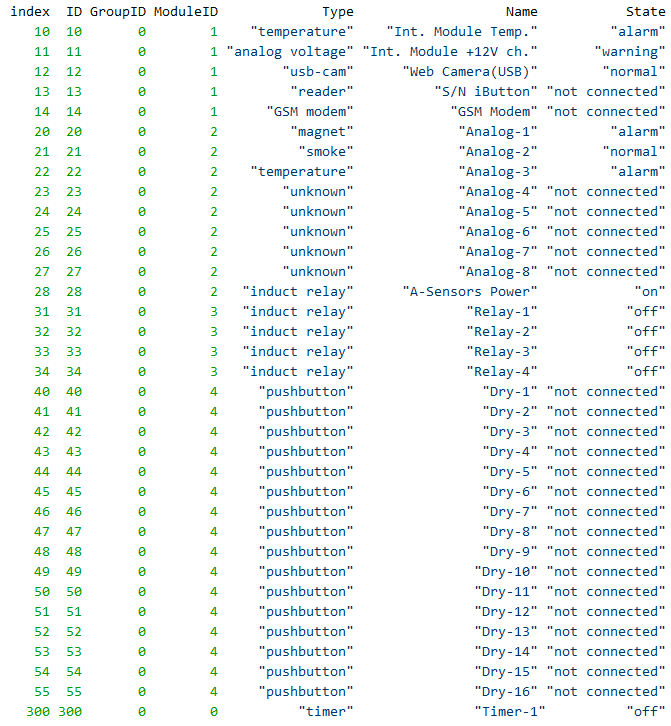Introduction – SNMP support of Didactum`s remote monitoring appliances and PDU`s
SNMP (Simple Network Management Protocol) is an common layer protocol for managing devices on TCP/IP network. Detailed information can be found here.
The Didactum Monitoring Systems can be controlled via SNMP protocol. This means that all remote monitoring appliances from brand Didactum offer an SNMP agent which can be controlled by an Network Management Base Station.
The SNMP agent of all Didactum remote monitoring devices is compatible with the MIB II RFC 1213 object model. The Management Information Base (MIB) is defined in accordance with ASN.1. Didactum remote monitoring units also support Trap Protocol Data Units (PDU). Trap PDU is the network management base station notification for changes that may occur during operation. After the base receives Trap, the base sends a query to monitoring appliance to identify the exact reason which caused the sending of the Trap.
The standard loading of Didactum monitoring device involves the launch of SNMP agent, as well as sub-agents. After start-up and communication between the agent and sub-agent, agent processes incoming requests from the network management station (manager) - SNMP PDU (Protocol Data Units), such as Get-PDU, GetNext-PDU, Set-PDU, etc., and generates a reply confirmation or Trap-PDU.
PDU Traps are specified dynamically in Didactum monitoring systems. The integrated logic is used to link trap messages in case of events.
SNMP Compatibility of Didactum IP monitoring units
All network-enabled remote monitoring appliances from brand Didactum support SNMPv1, SNMPv2c and SNMPv3 (encrypted).
Didactum SNMP MIB File
Open the web-interface of Didactum Monitoring System 100/400/500/500-DC/600 in your web browser. Didactum recommends use of Google Chrome, Mozilla Firefox or Safari. In Didactum`s multilingual webGUI, please open menu „Preferences“. Select from the menu “SNMP“ the entry "Download MIB file" and click on the „didactum.mib“ button to save SNMP-MIB file on your computer.
Didactum`s SNMP MIB-file contains information on the objects used by SNMP. The MIB-file can be imported with a MIB-Browser. The OID in the MIB tree have to be converted from numerical to character form.
$ snmptranslate -On DIDACTUM-SYSTEM-MIB::Didactum
Hint: Before importing MIB to your SNMP manager, please regard the documentation of your NMS.
Didactum MIB file represent the following list of tables (update 01/05/2014):
- ctlAllElementsTable - table of system elements, allows to view current status of all elements in Didactum`s monitoring system
- ctlAnalogsTable - analog sensors table, allows you to control analog sensors connected to the Didactum monitoring device
- ctlOutletsTable - relay table, allows you to manage integrated relays of Didactum Monitoring System 500/500-DC/600
- ctlDiscretsTable – table of dry contacts of Didactum remote monitoring devices with dry contact board option / dry contact inputs
- ctlTrapsTable – SNMPv1 and SNMPv2c Trap table
- ctlLogicsTable - table of logics for automatic actions of Didactum`s remote monitoring systems

For example your can give element with ID=21 a new name.
$ snmpset -v2c -cwrite 192.168.0.193 ZERTICO-SYSTEM-MIB::ctlAllElementName.21 s „Smoke sensor"
ZERTICO-SYSTEM-MIB::ctlAllElementName.21 = STRING: „Smoke sensor"
Overview of elements of SNMP enabled monitoring devices from Didactum
Didactum`s remote monitoring appliances may include following elements:
- Analog Sensors
- Discrete Sensors
- Virtual Sensors
- Notifications
- Units
Available elements of the monitoring system are liste in ctlAllElementsTable To view these elements just use command:
$ snmptable -Ci -Cb -v2c -cread 192.168.0.193 DIDACTUM-SYSTEM-MIB::ctlAllElementsTable

Analog Sensors from Didactum
The Analog Didactum Sensors have analog inputs and analog or discrete outputs. If an analog sensor is not connected or undefined, it will be in a state 'not connected'.
The analog sensor port number to which the sensor is connected, is determined by the field ctlAnalogHardwarePort
You can view analog sensors with
snmptable -Ci -Cb -v2c -cread 192.168.0.193 DIDACTUM-SYSTEM-MIB::ctlAnalogsTable

